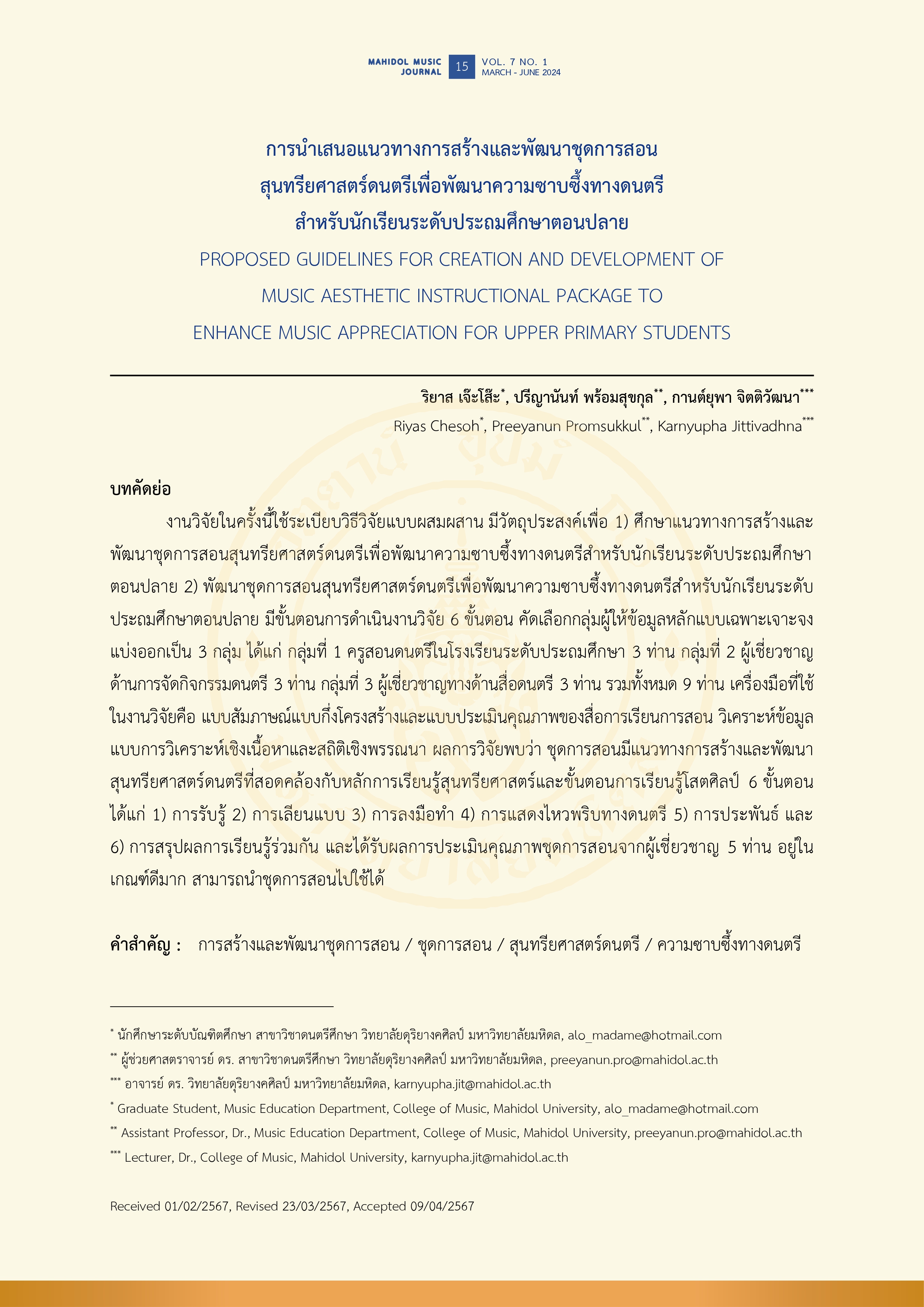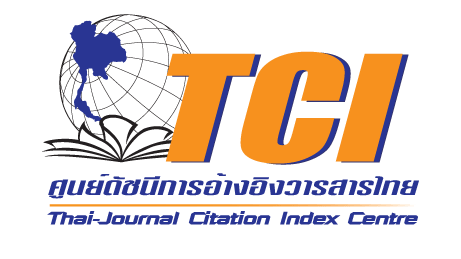PROPOSED GUIDELINES FOR CREATION AND DEVELOPMENT OF MUSIC AESTHETIC INSTRUCTIONAL PACKAGE TO ENHANCE MUSIC APPRECIATION FOR UPPER PRIMARY STUDENTS
Keywords:
Creation and Development of Instructional Package, Instructional Package, Music Aesthetics, Music AppreciationAbstract
This research is mixed-methods research and aims to: 1) investigate the guidelines for creating and developing a music aesthetics instructional package with the aim of enhancing music appreciation among upper primary students and 2) develop a music aesthetics instructional package that can effectively enhance music appreciation among upper primary students. The study consisted of six procedures, involving interviews with nine key informants selected through purposive sampling. These informants were grouped into 3: 1) 3 music teachers from formal educational settings 2) 3 experts in music activities 3) 3 experts in music media. Data, collected through semi-structured interviews and instructional package quality assessment forms, was analyzed using data analysis techniques and descriptive statistics. The findings of the study revealed that the instructional package offered guidelines for creating and developing a music aesthetic aligned with the concept of learning aesthetics and the six steps of learning audio art: 1) perception 2) imitation 3)practice 4) improvisation 5) composition and 6) summarizing learning results together. Moreover, an evaluation conducted by five experts indicated that the teaching packages exhibited a notably high level of quality, signifying their efficacy for practical implementation.
References
Broudy, Harry S. Building a Philosophy of Education (1954). 2nd ed. Englewood Cliffs: Prentice-Hall, 1961.
Charoensook, Sugree. Musical Aesthetics. Nakhon Pathom: Mahidol University, 1996. (in Thai)
Eungamporn, Nillawanna. "Sareerasamphan: Methodological Approach to Enhance Musicianship through Body Movement-Related Music." Doctoral diss., Chulalongkorn University, 2014. (in Thai)
Kant, Immanuel. Critique of Judgment. Translated by J. H. Bernard. New York: Hafner Publishing, 1951. (Original publication date 1892).
Limtasiri, Oranuch. Curriculum and Teaching at the Primary Level. Bangkok: Ramkhamhaeng University Press, 1999. (in Thai)
Mellor, Elizabeth Jane. "Aesthetic Perception in Music Education: Assessing Pupils' Compositions." PhD diss., University of Leicester, 1999.
Ministry of Education. The Basic Education Core Curriculum B.E. 2551 (A.D. 2008). Bangkok: The Agricultural Co-operative Federation of Thailand Press, 2008. (in Thai)
Nieminen, Sirke, Eva Istók, Elvira Brattico, and Mari Tervaniemi. "The Development of the Aesthetic Experience of Music: Preference, Emotions, and Beauty." Musicae Scientiae 16, no. 3 (November 2012): 372-391. https://doi.org/10.1177/1029864912450454.
Nimsamer, Chalood. Composition of Art. Bangkok: Thai Watana Panich, 1991. (in Thai)
Palarat, Laksanawat. Aesthetics. Bangkok: Ramkhamhaeng University Press, 2013. (in Thai)
Phancharoen, Natcha. Sankheetalak and Analysis. 4th ed. Bangkok: Ketkarat Publishing House, 2008. (in Thai)
Phatasoontorn, Pongpipat. "A Study of Auditory Perception of M. 11 Students with Different Background in Music Education." Master's thesis, Srinakharinwirot University, 1985. (in Thai)
Soonpongsri, Kamchorn. Aesthetics. 3rd ed. Bangkok: Chulalongkorn University, 2016. (in Thai)
Suriyut, Suppachai. "Qualitative Knowing: Qualitative Knowing in Music of Thai Muti-Cultural Inquiry." Master's thesis, Mahidol University, 2003. (in Thai)
Suttachitt, Narutt. Music Education Principles and Essence. 10th ed. Bangkok: Chulalongkorn University, 2018. (in Thai)
Ua-anant, Malichat. Reformative Art Education. Bangkok: Innovation Development Center Textbooks and Academic Documents, Chulalongkorn University, 2002. (in Thai)
Worakitkasemsakul, Somchai. Research Methods in Behavioral and Social Sciences. 2nd ed. Udonthani: Aksornsinkarnpim, 2011. (in Thai)

Downloads
Published
How to Cite
Issue
Section
License
Copyright (c) 2024 College of Music

This work is licensed under a Creative Commons Attribution-NonCommercial-NoDerivatives 4.0 International License.
The copyright of the article belongs to the author. Published articles represent the views of the authors. The editorial team neither necessarily agree with nor take any responsibility for the article.





